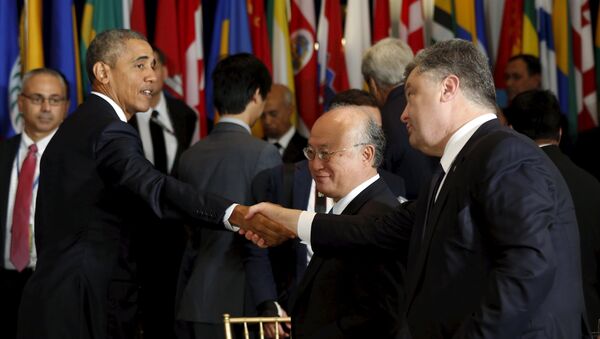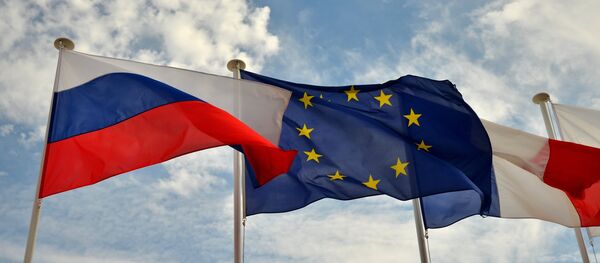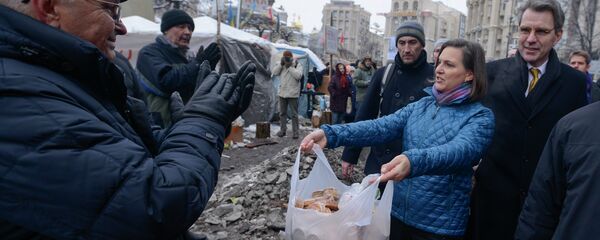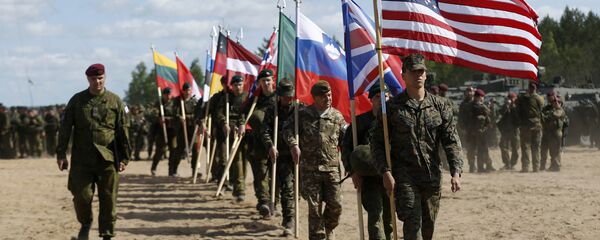The scenarios are presented as an analysis of events which may unfold in and around Ukraine between 2016 and 2018, and how they will affect Russian-American relations. To be sure, each of the scenarios presents events from the point of view of America's assumed national interests.
The first scenario, written by Samuel Charap, a senior fellow for Russia and Eurasia at the Washington-based International Institute for Strategic Studies, considers the conditions necessary for an improvement in US-Russian relations.
According to Charap, along with a series of other factors (from a deadlock in the Middle East to a shaky economic situation in China) a thaw in the bilateral relationship would require the situation in Ukraine to shift in a direction more conducive to compromise. This, in the analyst's words, might occur by means of a growing rift between President Petro Poroshenko and Prime Minister Arseniy Yatsenyuk, resulting in the collapse of the ruling coalition, and a new Ukrainian government more conciliatory toward the Donbass. With anti-Russian sentiment gradually fading, the EU would terminate most of its sanctions in 2016, with the US following soon after.
The second scenario, written by The National Interest contributing editor Nikolas Gvosdev, presupposes a growing division among European countries in relation to Russia, with the conflict in eastern Ukraine remaining unresolved and risking becoming 'frozen'. In 2017, in preparation for national elections, German Chancellor Angela Merkel is assumed to soften her tone toward Moscow, with other countries following Berlin's lead.
NATO, meanwhile, continues to struggle with internal contradictions which prevent the formation of a clear plan of action in relation to Russia and, by mid-2016, the EU partially lifts its anti-Russian sanctions, halting, at least temporarily, plans for its eastward expansion. The US, in turn, while rejecting the Europeans' backward sliding, continues to shift resources to Asia, and finds it difficult to build a coalition to balance against Russia. In any case, the new administration coming into office in 2017 is forced to choose between Moscow and Beijing, with the US military budget not allowing Washington to work against both emerging powers simultaneously. This leads to a strategy of selective pressure and engagement.
The third scenario, written by Wilson Center Kennan Institute Director Matthew Rojansky, examines the prospects for a continuing deterioration of relations between Moscow and Washington, leading to a long-term 'Cold War-esque' confrontation. In his scenario too, the Donbass conflict effectively becomes "the latest and largest frozen conflict in the post-Soviet space," but this does not lead to renewed stability or normalization.
In his write-up of the think tank's analysis, Svobodnaya Pressa journalist Andrei Polunin points out that "in all three scenarios, Washington is expected to consolidate its gains in Ukraine, and to secure the advantages gained in global geopolitical structures. At the same time, the Americans do not intend to 'defeat' Russia at the cost of losing to China."
Speaking to the independent online newspaper, Sergei Ermakov, the deputy director of the Moscow-based Russian Institute for Strategic Studies, noted that the study indicates that the US realizes the Ukrainian crisis's central role to European security.
"US analysts write such scenarios in order to model the situation and to clearly identify where US interests are the most secure and feasible. As is evident from the Center for the National Interest's projections, the crisis in Ukraine, from Washington's perspective, is the dominant factor in the structure of European security. That's certainly something that would be difficult to argue with."
"It's another matter that the American contemplation on a split between Poroshenko and Yatsenyuk cannot be taken literally," Ermakov suggests. "It is hardly possible to consider seriously the idea that the Ukrainian elite controls the situation in the country."
"In practice, Washington is now seriously discussing the idea of Ukraine's federalization. Kiev had rejected Moscow's proposals in this regard, but now the West is attempting to 'implant' it, with Ukrainian intellectuals reacting quite favorably. In this situation, the think tank's 'probe' on the idea of a possible conflict between Poroshenko and Yatsenyuk indicates that the path to federalization may progress exactly along such a scenario."
"Of course," Ermakov suggests, "the US itself could call the process on federalization something else. For example, it could come down to the 'autonomy' of parts of the Donetsk and Lugansk regions, or their 'special status'. Nevertheless, what is at stake is federalization. Moreover, it will affect not only the eastern, but the western regions as well. In western Ukraine, local elites also want to play a greater role, and the break between them and the center is growing wider. A Federal Ukraine, according to Washington, could play an essential element to a new security system in Europe. And it will be built around a compromise with Russia."
Asked to outline his own vision on how relations between Moscow and Washington might unfold in the next several years, Ermakov noted that in his view, in the next three years, Russia will make an effort to modernize its military and to achieve a sense of parity with the US.
"At the same time, Moscow will try to find compromises with Washington on a tactical level, followed by a more stable model, based on a balance of power. Another possibility, of course, is a worsening of the situation in the Middle East or the Donbass. But here much will depend on the new US administration – on which forces support the new president, and whether they will be able to come to an agreement on the reformatting of relations with Russia."





